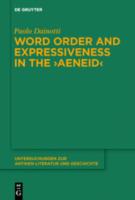
De Gruyter (2015) h/b 294pp £97.99 (ISBN 9783110384222)
In this stylistic analysis D. gathers numerous examples that help to determine how changes to normal word order produce expressive effects. Readers of Virgil will certainly be alert to the common features discussed in this book, such as enjambment, hyperbaton (golden lines—‘a clear neoteric affectation’—juxtaposition, emphatic initial and final positions in the line), polyptoton or metrical effects. However there is some technical terminology that will be less familiar, such as iconicity, rejet, contre-rejet and après-rejet, or perhaps synaloepha.
Iconicity receives some detailed treatment in the introduction since in classical scholarship the term ‘has only recently begun to be used for well known phenomena, generically labeled as expressive.’ Acoustic images are most easily seen in onomatopoeia, and visual images in pattern poems, but iconicity has a broader range, and D. discusses a variety of types. Grammont’s 1913 definition of rejet is quoted on p.22 note 81: ‘an effect of contrast produced by the fact that the syntactical phrase does not coincide with the metre.’ Thus far it looks like a synonym for enjambment. However, the observation that ‘a longer rejet will actually have less expressiveness than one consisting of a single word’ leads D. to narrow the definition. On p.58 it is to be used exclusively for ‘those instances of a run-over word, where enjambment consists of a single word run over to the next line, placed in initial position and before a syntactical pause.’
Contre-rejet is used for an enjambment created when a phrase ends before the line ends, causing the next phrase to run over into the next line. D. also adopts the term après-rejet for ‘the syntactical passage which follows the rejet, used with precise stylistic effects.’ Synaloepha is the coalescing of two syllables—in effect, elision, but perhaps a more accurate term.
D. has assembled a huge range of examples (the index locorum covers six and a half pages) and has arranged his analysis in three chapters covering verse, rhythm and word order. Each chapter is neatly subdivided (for example synaloepha is discussed in relation to word order, rhythm, hypermetric lines, hiatus). The assemblage is impressively detailed (pp. 59-61, n. 196 on rejet of verb forms and participles, occurring in 3.6% of lines in the Aeneid, gives a comprehensive list).
But this book, as the title indicates, attempts to do far more than catalogue examples. It keeps its focus on the use of word order to enhance the expressiveness of the language. Enjambment (for example) may not enhance the effective (or affective) delivery of content, and there are no external rules one can apply to know whether it does, only an analysis of each context. On this D. is insistent: for example at the opening of chapter 2, he reiterates the importance of context: ‘a certain rhythm is not expressive per se, but must always be weighed and measured within its context and in the light of its significant convergence with other stylistic factors’. D. also adds as a check ‘comparison with passages which display clear thematic and formal analogies’. For example, D.’s discussion of the well-known stylistic effects of a monosyllabic line ending (pp. 206-216), finishes with Aen. 2.170 spes Danaum, fractae vires, adversa deae mens in which asyndeton, ascending tricolon and the final colon’s syllabic diminuendo (3-2-1) all add to the effect of the monosyllabic ending in ‘closing the period with a strong image: the goodwill of the goddess is now lost’. Such readings make this an attractive analysis, and one that should provoke further discussion. A must for Virgil scholars, a useful tool for teachers and advanced students, this is not a book designed to appeal to the reading public.
Alan Beale
